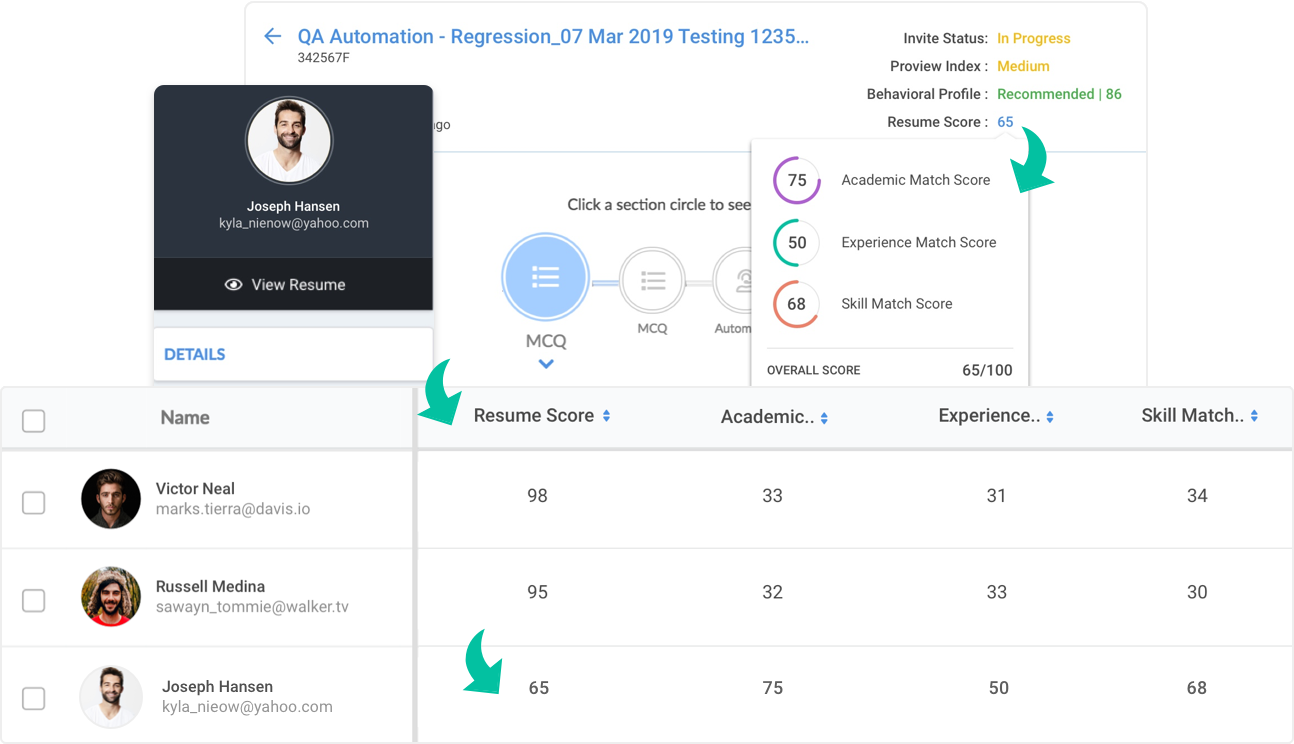"For every 100 candidates you screen, you need to shortlist 12 of them to interview, two of them will receive an offer, and one candidate will accept to result in one successful hire."
Now that I have your attention with this daunting fact, let’s jump right into the topic.
In this blog, I will be covering the following topics:
- Screening process and its importance
- Manual Screening and Scorecard solution
- Challenges faced by recruiters in manual screening
- Investing in an ATS
- Resume Screening Tools and Software - Benefits of Automation
- Conclusion
What is Resume Screening?
As you might know, resume screening is a part of a bigger hiring process that starts with planning - when a vacancy arises, and ends with sending the offer letter. The 5 main steps of recruitment are:
- Planning
- Strategy development
- Sourcing
- Screening
- Evaluation and control
Gone are the days when enterprises would recruit merely on the basis of a resume and/or cover letters. Things have gone beyond recruiting for an open position or for getting the work done. Enterprises are increasingly hiring for talent and resourcefulness, for future-proof soft skills and transferable skills. Likewise, today’s workforce is also on the lookout for mission-driven employers. People want more than just a paycheck from the organization they work for, they want to have a sense of purpose in their job.
And, just like today’s consumers, job seekers often want their own values to align with those of their company.

Going through resumes is the oldest method of determining if someone is the right fit for the job. It is established that resumes aren’t the best indicator of a candidate’s skills and potential. They play a big role in highlighting the candidates’ key achievements and are a vital consolidation of a candidate’s skills. But what employers are looking out for these days is teamwork, creativity, problem-solving capacity, digital literacy and so on, which cannot bear much proof in a written resume. Then why are we still spending time and effort on CV screening?
The paradox here lies in the fact that without a resume screening process, hiring is needlessly labor-intensive. Instead of improving the hiring process and receiving the most promising candidates, attracting large numbers of new applicants can slow down your hiring process. This is why having a structure in place for your resume screening process can help you make the most of all the applications you receive.
Here is why having a structured resume screening process is useful and important:
- It not only ensures consistency and efficiency in the applications you get but also helps in giving a good candidate experience with a streamlined process. Over time, this consistency will help the hiring managers to learn the pattern of the kind of applications they will receive and how to move forward with the rest of the process, modifying and improving the process with every hire.
- If there’s a proven system that works for the organization, there are fewer chances of missing good opportunities or candidates. There is a lesser chance of you missing out on a candidate you are looking for, as you will know the kind of applications you attract, what kind of candidates you want, and make the changes accordingly. You will be forced to distinguish between must-have and nice-to-have criteria.
- If you have a system in place, you can easily avoid hiring unfit candidates, and/or having unconscious biases while screening and make the process fairer. This not only helps avoid favoring one candidate over the other, but it also helps increase diversity and best fits in the organization.
These reasons should be enough for you to realize the importance of having a structured process in place.

Steps of Manual Screening
For manual CV screening, the first step in your checklist should be to understand which skills, traits, and behaviors are necessary to be successful in the role. It could be Work Experience, Education, Skills, Knowledge, and Competencies, Personality Traits, etc. These could be easily identified if you are hiring for an existing role. Finding common traits of an existing employee, speaking with supervisors about essential traits for the job to be done well and forming a JD accordingly.
Once these are identified, you should classify these skills, traits, and behaviors into desirable traits and essential traits. Essential traits are ones that a candidate must have in order to do the job. An example of that for a retail associate would be good written and verbal communication skills. Communication is an essential part of a retail associate’s job, without which his/her job is absolutely not possible to do. Desirable traits are ones that would make someone a stronger candidate. An example of desirable traits is prior work experience in the same industry. These would be an addition to his/her current qualifications to excel in his/her job.
Here, one needs to understand that a candidate would be unable to do the job without each essential trait whereas s/he would still be able to do the job without any of the desirable traits. For example, an extroverted candidate with good communication skills (essential traits) who lacks prior retail experience (desirable trait) can be successful as a retail associate with some training.
Depending on the job requirements, candidates can be screened based on desirable traits, essential traits, or both.
Remember, both essential and preferred qualifications and traits should be set out as part of the Job Description. They provide the framework for attracting the right applicants and building the interview process, which allows you to dig in and verify whether a candidate has the skills and experience required for the open position. The creation of a job description requires participation and involvement from managers/team leaders along with the hiring manager as they are the ones who will be directly working with the candidate, once selected. They will be the ones who know what qualifications and traits are essential to get the work done and who will better fit their team and who won’t.
Scorecard

Once you have your job description at hand, it is easy for you to attract the right talent. The next step now in manual resume screening is to maintain a scorecard of all the traits, qualifications, and job requirements and score each candidate on that. Maintaining a scorecard is one of the best practices in manual screening to streamline your interview questions and also have an unbiased score for each candidate. Once you start maintaining a score for each candidate for each required trait or qualification, it becomes easier for more suitable candidates to clearly stand out among the ones that don’t match the criteria, and for you to decide who to hire on a merit basis.
Challenges to Manual Resume Screening
Survey after survey reveals employers/recruiters complaining about how difficult hiring is today. There may be many explanations, such as companies having become very picky about candidates, and having to cater to changing market trends, competition, and cultural fit. But clearly, hiring has shot up more than at any other time in modern history. LinkedIn reports that 69% of talent acquisition leaders state that their hiring volume has increased this year, but only 26% of their recruiting teams have increased.
One major pain point for recruiters while screening is the volume. If the company has to hire employees for one or two roles, it is not a big task. The challenge occurs when you receive a huge number of applications that increase the time to fill. The burden on the recruiter increases and it gets harder for the recruiter to sift through all the applications to find the right candidates. Another challenge in that is that most of the resumes are redundant and/or rejects, hence the task becomes lengthy and tiresome.
Another challenge in the process is the quality of hire. A higher number of applications do not promise quality candidates. Hence, a lack of skilled, quality talent in a demanding location and industry can really change the game for employers.
An increased focus on finding the right talent and not making a poor hire has contributed to extending the time to fill beyond 30 days. Despite the challenges that arise due to having a vacant position, it’s even worse to fill a job with the wrong candidate to just hose down the situation to deal with at a later date. It's increasingly becoming from an employer-centric market to a candidate-centric one.
Invest in an ATS
The usual solution for the problem of volume hiring is to use an Applicant Tracking System. An ATS is a must-have software for recruitment and talent acquisition departments in any organization as it organizes all the resumes received for each role in one place and enables recruiters to separate and arrange them according to their fitment and ability. In theory, ATSs also save time by automatically surfacing and highlighting top candidates. In reality, ATSs help hiring professionals narrow their applicant pool, but top candidates slip through the cracks sometimes. Corporate recruiters or hiring managers can search and sort through the stored resumes in a number of ways, depending on the system they’re using.
An ATS usually allows for some measure of automation in resume screening through keyword matches or questions.
Drawbacks of having an ATS for Resume Screening
While an ATS may be effective for addressing the issue of volume, traditional ATS software isn’t designed to measure the quality of hire. Since an ATS doesn’t have a way to learn which candidates went on to become successful and unsuccessful employees, it can’t improve its screening function over time.
71% of recruiters use an ATS that doesn’t have the option to rank the resumes of the candidates they receive.
An ATS’s limited functionality means recruiters need different software tools to help them achieve their most important KPIs, quality of hire being one of the most important one.
For example, an ATS can screen in a candidate as a false positive based on keyword stuffing or screen out a candidate as a false negative because s/he didn’t meet the keyword filters but have strong qualifications otherwise.
Solution? Automation.

The new class of recruitment solution - AI for recruitment is paving the way for a new age of hiring faster and better with minimal human intervention. It has reached deep into the industry with its roots spread in almost every aspect of Human Resources.
Over the years, large companies tend to accumulate thousands – even millions – of resumes that merely sit in their ATS. Automated candidate resume screening has the potential to solve this resume “ignore” problem that continues to plague recruiters.
Jobvite reports that an average job posting receives 50 or fewer applicants. Job postings for high-volume roles such as retail, however, receive more than 250 applicants.
On average, 65% of resumes received for high-volume roles are completely ignored. These are candidates you’ve paid to attract and source for your open role.
The problem is that once these resumes get collected into your ATS, the majority of them are never looked at again. There is no known feature that enables one to clear the database or use it when it is required. Due to this, a vast amount of data ends up being unused. This is one major drawback of relying on an ATS for resume screening.
Enterprises should evaluate new HR software based on its ability to improve efficiency and automate processes.
Automated resume screening works in four basic steps:
First, it integrates into your existing ATS and adds a layer of an intelligent screening function.
Then, it scans your JD to understand the qualifications and traits needed.
Once that is done, it screens every resume you receive for the qualifications you set as standard to qualify for the job, like education, work experience, and skill set to find the best matches for the job.
Finally, it ranks every candidate for your open role (e.g., A to D).
Benefits of Automation
Reduced Time to Hire:
Automating your screening process will bring your average time to hire significantly. Once this is tackled, everything else becomes much easier and faster, also ensuring that you don’t lose out on talent to faster-moving competitors.
If your system automatically screens, grades, and ranks every single resume you receive, you’ll no longer overlook qualified candidates due to time constraints.

Increased Quality of Hire:
Reducing time to hire directly affects the quality of your hire. An average talented candidate stays in the market for approximately 10 days before s/he is approached by an organization. To ensure you get your hands on that talent before anyone else, bringing down the time to hire is directly related. Other factors that affect the quality is a streamlined and consistent candidate experience that comes with automation which will attract the right candidates to you.
Here are 5 steps to help you hire quality candidates.
Structured and Streamlined:
Having software enables a more stable and structured screening process. This promises consistency and unbiased candidate screening throughout the process.
Increased Candidate Experience & Brand Image:
As mentioned previously, once the process becomes more structured, it automatically increases the candidate experience. More candidates get impressed by your process, the more it improves your brand value in the market, making it easier for you to attract quality talent faster.
Reduced Biases:
Apart from that, having technology take care of your functions ensures minimal interview biases. Recruiters more often than not fall prey to having biases. If screening is completely taken care of by software, it guarantees you a pool of actually qualifying candidates or potential employees. No need to worry about redundant applications.
Read more for a detailed understanding of interview biases.
Talview Resume Screening & Scoring
Talview offers one of the best screening platforms in the industry. With Talview, in offline hiring drives, you can assign multiple candidates to a panel in one go, instead of scheduling candidate interviews individually. Recruiters will know which panel is assigned to the candidates, while the panel can evaluate the candidates on the go by filling out a form at the end of each interview
You can have all the data of the recruitment process captured in a single place and save time for something better as the screening software looks through candidate resumés and scores them for you. You can sort the resumé scores and pick the most relevant applications. Our integration with Skillate - a smart recruitment product that has an AI algorithm trained with over 20 million diverse profiles has enabled an in-house feature to parse and get resumé scores in one place. Now with resumé scores, screening from a pool of applications is easier than ever!

Apart from that, with the TBI results of each candidate, you can also ensure that you’ll find culturally fit candidates.
New to our blog? Read this to know more about the science behind Talview Behavioral Insights.
Conclusion
Now that you are aware of the perks and pitfalls of automated or manual CV screening, this blog should help you narrow down on whether you want to continue spending your time and resources on redundant activities or you want to make your screening process more relevant, swift and hassle-free.
A systematic and fair way to filter job applications can work wonders for both the candidates' experience and the efficacy of your own hiring process. It's a win/win proposition, enabling you to find the right candidates in less time. The important thing to remember is that your screening process should be applied consistently and objectively across all resumes and applications. No exceptions.
At the end of the day, you need to understand the operations of your organization, weigh the options available, and see which one suits the process in your organization the best. To choose what’s best for you and your organization, you need to do your homework and research the best providers for the job at hand.
Want to know more about what we do? You can request a demo with us.



Leave a Reply